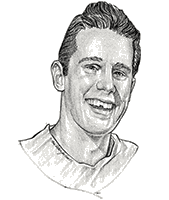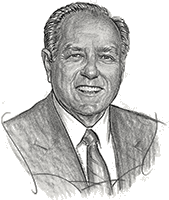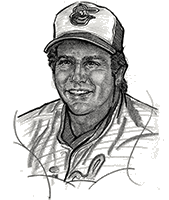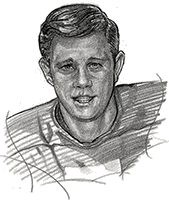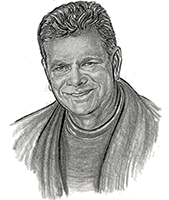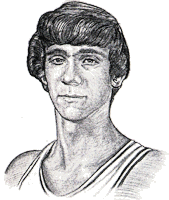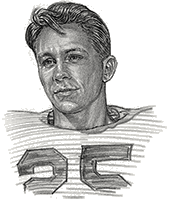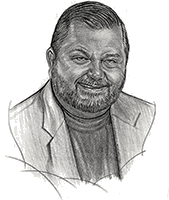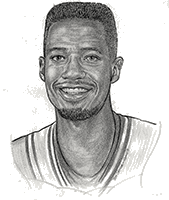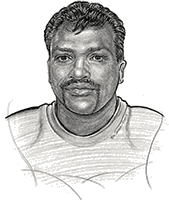Member of 1968 U.S. Olympic Hockey Team. Collegiate All-American at Michigan State in 1966 when he scored 27 goals and assisted on 30 others in 30 games to leas his team to the national collegiate championship. Was first American-born player to complete season as leading scorer in Western Collegiate Hockey League, considered the strongest college league in the United States.
As a native Clevelander he was treated to the successes and subjected to the agonies of the Cleveland Indians form his earliest childhood. After graduating from West Tech in 1946, serving two stints in the U.S. Marines, and failing, thanks to a recalcitrant bat, in an attempt to personally improve the Tribe’s fortunes by signing on as a catcher in their farm system, he sharpened his skills by acquiring a degree in English from Baldwin-Wallace College and eventually found his way to a desk in The Plain Dealer sports department, where he would assume the task of covering the Indians in 1964 and eventually become a nationally known chronicler of the Indians fortunes and history. It was a labor of love—often touch love—for the first 14 seasons as he covered a succession of teams which finished as high as third only once. He was reassigned, perhaps mercifully, to cover the more successful Cleveland Browns in 1978. Then in February, 1984 he assumed a new role as the paper’s investigative reporter for sports and in 1988 his assignment was further broadened to that of national baseball writer, columnist and special assignment reporter. The latter assignments were tailor made for the hard-nosed Schneider who thrived on burrowing deeply into the facts for his news stories. Firmly established in the eyes of his peers and the public as a reporter’s reporter (he has been inducted into three journalism-related halls of fame and earned a Distinguished Service Award from the Society for Professional Journalists), he embarked on a new career in 1993 as an author, primarily dealing with Cleveland Indians history. He has written a dozen books, including The Cleveland Indians Encyclopedia, now on its third edition. He makes his home in Seven Hills.
Raised in South Euclid, he became an all-state baseball pitcher at Brush High in 1965, then matriculated at Kent State where he teamed with catcher Thurman Munson to form what might have been the most impressive battery in Ohio collegiate history. Signed with the San Francisco Giants in 1969 and began his major league career with them in 1971. After two years with the Giants and six years split between the Chicago White Sox and Chicago Cubs, he was traded to Baltimore in 1979 and pitched for them in the World Series that year. He reached his zenith the following season, when he became the American League’s Cy Young Award winner after putting together a 25-7 record and pitching in the All-Star game. Turned to broadcasting after the 1981 season and was in his 18th season of doing the Chicago Cubs play-by-play on WGN-Radio at the time of his induction, teaming up with the legendary Harry Caray for the first 15 of those years.
One of Greater Cleveland’s top high school athletes in the early ’60s, he climaxed a brilliant football career by quarterbacking St. Joseph High to a 9-0-1 record as a senior in 1963 to earn a spot on the All-Ohio team as selection as the area’s outstanding scholastic by the Cleveland Touchdown Club. Moving on to Notre Dame, he played quarterback as a sophomore, then was converted to safety for his final two seasons. As a defensive player, he gained All-American as a senior when he set several school records that were to stand for more than 25 years, including most interceptions returned for touchdowns and most yards gained on punt returns in a game and a season. He was drafted by the Cleveland browns in 1968, but a stint in the Army put his professional career on hold until 1970 when he put in one season with the Browns. After several years in the business world, he returned to St. Joseph as an assistant football coach in 1988. He became the Vikings’ head coach in 1995 and added the duties of the athletic director in 1998.
Deceased 2023
One of the most dominant male golfers in Northeastern Ohio over the last three decades, he came out of St. Joseph High to earn a scholarship to the University of Alabama where would gain an eighth place finish in the 1978 College All-American Classic and All-SEC second team honors. By then he had already won the first two of his three Ohio Publinx championships and the 1977 Ohio Amateur championship. He added his third Ohio Publinx title in 1978 and was crowned the Ohio Open Champion in 1979. Honors kept piling up from there: seven Player of the Year citations on the NOPGA (Northern Ohio PGA) section, three NOPGA Match Play Championships, two NOPGA section championships, and most recently the 2008 Senior Open Championship. In 1996 he competed in the U.S. Open at Oakland Hills Country Club and in a signature moment found himself tied for fifth with a 69 after the first day. He has twice turned in scores of 61, but neither matched from a pride standpoint the 64 he fired at Aurora Country Club to tie the course record held jointly by Arnold Palmer, Bruce Devlin and Charles Coody. He was the head pro at Aurora from 1991 to 2005 and now manages and operates Strongsville Golf.
Arguably the best high school basketball player ever to come out of Greater Cleveland’s small school ranks, he enjoyed a fabled career at Cuyahoga Heights High, culminating with his selection as an All-American in 1973 after leading the state in scoring with a 32.9 ppg average and being named Ohio’s Class A High School Basketball Player of the Year. Those feats earned him a scholarship to the University of Minnesota where he stepped right in to a starters’ role. The heady backcourt general started 101 of the 103 contests he played in for the Golden Gophers and as a senior helped lead the team to a then school best 24-3 record. His playing career ended with that season, but not his association with basketball. A transformation from player to coach was made as easily as the step up from Cuyahoga Heights to Minnesota basketball. It began with four seasons guiding the fortunes of Grand Valley (MN) Lutheran College to a 92-13 record including a perfect 56-0 home court mark, continued through the major college ranks as an assistant for seven successful season and seven more impressive years as a CBA head coach, then culminated in a move to the Minnesota Timberwolves as the NBA team’s general manager in May 1995. It was a job that lasted only until he asked to take over as the team’s head coach seven months later, a position he still fills with the distinction that has marked his entire career.
Deceased 2015
A native Clevelander who starred in football, basketball and track at Cleveland West High from 1945 to 1948, he stayed on to give his hometown reason to continue cheering his feats at Case Tech. and continue to cheer it did as he literally fashioned a Hall of Fame career for the Rough Riders from 1948 to 1952. Relatively slight, even in those days, for a halfback at 170 pounds, his speed and elusiveness enabled him to post some impressive numbers on the gridiron—none more so than on Thanksgiving Day in 1950 when he broke away on touchdown runs of 56 and 97 yards to give Case a 20-7 victory over archest of rivals Western Reserve. It was an effort that went a long way toward earning him the 1950 Les Bale Award as the team’s “Most Outstanding Player.” That was followed by the Cleveland Touchdown Club’s 1951 award as the Most Outstanding Local Collegiate Football Player, and a berth on the 1951 All-Big Four Offensive First Team. While honors piled up for his football skills, he quietly fashioned records in track as well, leading the team in points scored in 1950, 1951 and 1952 and setting a school record of 24.0 sec in the 220-yard low hurdles. Theiling, who now makes his home in Willoughby, was elected to the Case Western Reserve Athletic Hall of Fame in 1976.
Deceased 2020
Joe left the comparative tranquility of rural Illinois in 1970 to accept an offer to come to Cleveland and become the radio play-by-play voice of the newly formed Cleveland Cavaliers. It turned out to be one of the best deals the Cavs ever made. Certainly none of their transactions have had a longer lasting impact on the community. Beginning his broadcasting career in 1956 as an undergraduate at Monmouth College by airing the games of his beloved future alma mater, he happily stuck with it for 14 seasons before the Cavs uncovered him. Now, when the Cavs’ 2005-06 season opens he will be starting his 51st year in broadcasting, his 34th season with the Cavs and his 36th year of doing NBA basketball (he left to broadcast the New Jersey Nets games in 1981-82 and those of the Chicago Bulls in 1982-83). Even in his two seasons away from the Cavs, his familiar baritone continued to boom across the Cleveland airwaves calling the games of the Cleveland Indians on radio and/or TV, assignments be handled from the 1972 to the 1988 seasons. In 1988, Cavaliers management, deciding perhaps the man might have some promise, tightened their grip on him by naming him their broadcast vice president. Now the unchallenged dean of Cleveland sportscasters, he has, entering the 2005-06 season, broadcast 2,747 Cavaliers games as well as all 188 games of the organization’s currently defunct women’s counterpart, the Cleveland Rockers, plus well over 2000 Indians contests. In addition, he has been the TV voice of Mt. Union College football for 17 years. During these years he has been chosen the Ohio Sportscaster of the Year eight times, and will be entering his sixth Hall of Fame with his induction into the Greater Cleveland Sports Hall of Fame. But who’s counting?
Warrensville Heights already boasted an enviable record as a small school which produced outstanding athletes when one of its future students began his adolescent growth spurt in the mid-70s. By the time he reached high school age, he was nearly seven feet tall, and while he was a bit on the spindly side, it was evident that WHS was on the brink of welcoming its next quality sports star in the person of basketball prospect Brad Sellers. Hope became reality, and by the time he reached his senior season, major college scouts were beating a steady path to the doors of the Tigers gym. Wisconsin won the recruiting battle and Sellers enjoyed two good seasons in Madison, averaging 15.3 points and nine rebounds over 55 games in 1981-82 and 1982-83. His 838 points made him just the fourth UW player to top 700 by the end of his sophomore season. But, at the end of that second season, he elected to transfer to Ohio State, where he stepped it up a notch, averaging 17.8 points and a prodigious 10.8 rebounds over two years. His 416-rebound total in 1985-86 still ranks as the fourth best single season total in OSU history. Even more impressive, his 187 blocked shots rank as the Bucks’ third best CAREER total. The Chicago Bulls made him the 9th pick in Round One of the 1986 NBA draft and he went on to play the first three of his six NBA seasons with Chicago, then split three ensuing campaigns among Seattle, Minnesota and Detroit. Although his best season was the 1987-88 campaign with the Bulls when he started 76 games averaging 9.4 ppg, his most memorable moment may have come in the 1987 playoffs when he made the last second pass to Michael Jordan that Jordan converted into “The Shot” which eliminated Cleveland from the playoffs. Still living in Warrensville Heights, he is now the city’s community liaison director.
The persuasive conviction of a high school coach and the willingness of a college recruiter to take a gamble on a 6’3″ 185 lb linebacker paid handsome dividends for this East Cleveland native. Limited by an injury to only three football games as a senior at Shaw High, after playing in just seven varsity contests as an underclassman, he nevertheless found himself the recipient of a scholarship to West Virginia University. Good deal all around. In his sophomore year at WVU, he was All-East for the first of two seasons, and as a junior was getting All-American mention. After finishing his college career in 1982 as WVU’s career leader in assisted tackles and tackles for a loss, he was selected to nine All-American teams and became the school’s first consensus All-American in 27 years. Drafted by the Buffalo Bills in the second round of the 1983 draft (39th pick), he began an 11-year career which took him to Super Bowl appearances in 1990, 1991, 1992 and 1993, earned him selection to the 1990 and 1991 Pro Bowls and eventually to a place on the Bills’ Wall of Fame, the 20th player so honored. When he left the Bills in 1994, he took with him the honor of being Buffalo’s all-time leading tackler. He played for Atlanta in 1995 and Minnesota in 1996, then signed a contract with Buffalo in 1997 and retired—as a Bill. Darryl now makes his home in Orlando, Florida, where he runs a traffic control company.
2001 Crocker Rd., Ste. 510, Westlake, OH 44145
Phone: 216-241-1919

